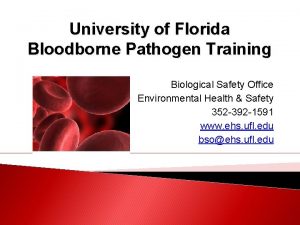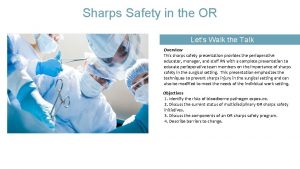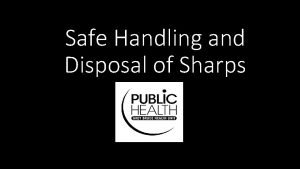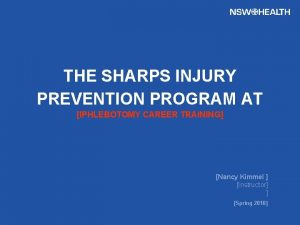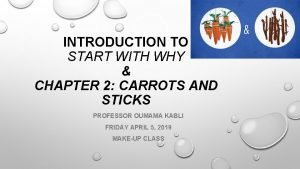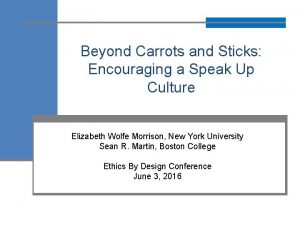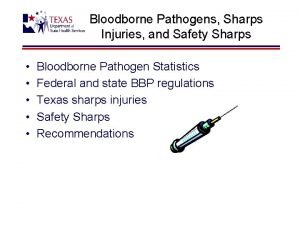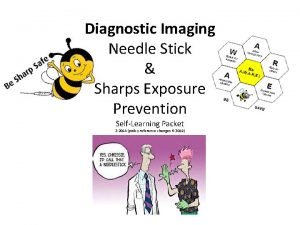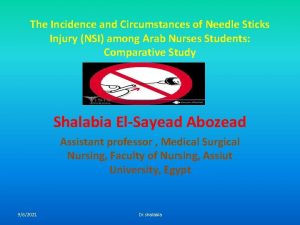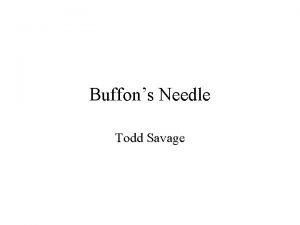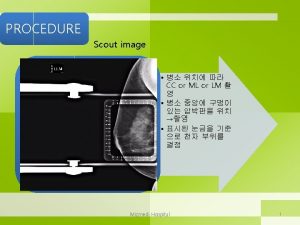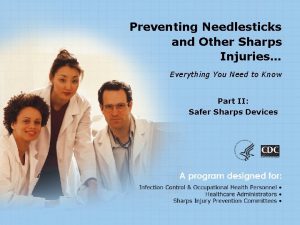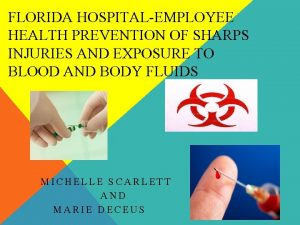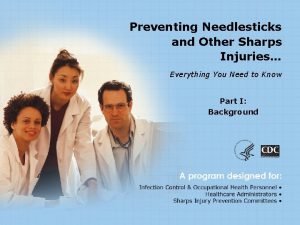Decrease Sharps injuries and Needle Sticks in the











- Slides: 11

Decrease Sharps injuries and Needle Sticks in the Operating Room Nabil Hamam Practicum 2014

Overview of host organization DMC Surgery Hospital, one of nine hospitals and institutes operated by the Detroit Medical Center (DMC), DMC’s Orthopedic programs bring together a spectrum of expertise that has earned DMC a reputation for excellence in the field of bone and joint disorders, including: � Fractures � Trauma � Joint replacement � Sports medicine � Occupational medicine � Podiatry � Osteoporosis prevention and treatment

Background of site supervisor Carolyn Kidd Clinical Manager of Operating Room �She has 20 years of experience in the Operating room. �Management , surgeries, Circulating, Assisting and budgeting the OR. �Hobbies: Cooking, listening to music

Practicum Overview -A sharps injury is a penetrating stab wound from a needle, scalpel, or other sharp object that may result in exposure to blood or other body fluids. -Operating rooms present special challenges in reducing the risk and number of sharp injuries. - To develop strategies for reduction of contaminated injuries to members of the OR, it is important to examine the patterns of injuries. - Limited space and visibility within operative fields and distraction might increase the risk of sharp injuries.

Objectives � 1) To determine whether injections are given in the OR meets necessary requirements for staff competence, equipment, supplies and waste disposal. � 2) To determine whether the critical steps of an injection administration are executed according to recommended best practices. � 3) To identify the unsafe practices that may lead to infections and that should be targeted by interventions to improve injection safety and occupational health. � 4) To estimate the proportion of health care facilities where injection practices are safe. � 5) To determine whether the policy and practices to protect healthcare workers from preventable exposures to sharps and blood borne pathogens and whether post-exposure surveillance, follow-up and prophylaxis are in place. � 6) To estimate the frequency of needle stick injuries from contaminated sharps among injection providers and waste handlers. � 7) To determine the proportion of needle stick injuries which are not reported.

How do sharps injuries occur? � In addition to the use of sharps devices, injuries are also closely associated with certain work practices that can pose an increased risk of blood borne pathogen exposure. These work practices include: � Disposal-related activities (11%) - DMC (16%) � Activities after use and prior to disposal, such as item disassembly (30%)- DMC (23%) � Recapping a used needle (3%)- DMC (5%) � During use of sharps (48%)- DMC (56%) � others (8%) - DMC N/A

Sharps injuries overview DMC Surgery Hospital During use of sharp After use/ prior disposal 23% 1 st Qtr 2 nd Qtr 3 rd Qtr 56% 4 th Qtr 16% 5% Disposal –related activities Recapping a used

Lessons learned how I am plan to integrate theory into practice - -Conduct a focus group - - Select a model - - Communicate, Educate - - Implement the model and Evaluate

Current status of practicum including clock hours to date -Started May 6, 2014 – Finished August 10, 2014 -225 hours are completed -Work plan completed -Evaluation is completed - Practicum is completed

Preventive Measures 1 - ELIMINATING THE UNNECESSARY USE OF SHARPS IN THE OPERATING ROOM 2 - IMPLEMENTING SAFE SYSTEMS OF WORK BY USING (NEUTRAL ZONE) 3 - IMPLEMENTING SAFE PROCEDURES FOR USING AND DISPOSING 4 - BANNING THE RECAPPING OF NEEDLES , AND USING OF BLUNT NEEDLES 5 - USING PPE DOUBLE GLOVING, AND TEACHING AND TRAINING. (DURING MY EIGHT WEEKS PRACTICUM; NEEDLE STICKS INJURIES HAS BEEN REDUCED SIGNIFICANTLY. WE ONLY HAD ONE NEEDLE STICKS INCIDENT BY A CLEAN NEEDLE).

References � Susan Wilburn , Needlestick Injury Prevention Assessment Tool, March 2005. Assessment of injection safety (Who 7 V&B/01. 30) � WHO 2013 , Retrieved June 06, 2014 From www. who. org/ needlesticks
 Input and output markets
Input and output markets Solfege with sharps and flats
Solfege with sharps and flats How many splash exposures were reported at uf in 2020
How many splash exposures were reported at uf in 2020 Key signature rules
Key signature rules Sharps neutral zone
Sharps neutral zone Sharps tongs
Sharps tongs Contractor management chemical
Contractor management chemical Sharps injury prevention program
Sharps injury prevention program Start with why carrots and sticks
Start with why carrots and sticks Nursery rhyme sticks and stones
Nursery rhyme sticks and stones Sticks and stones origin
Sticks and stones origin Beyond carrots and sticks
Beyond carrots and sticks


